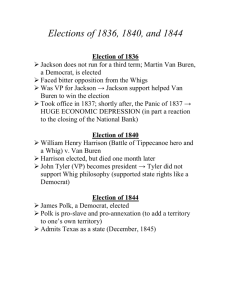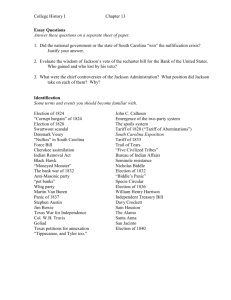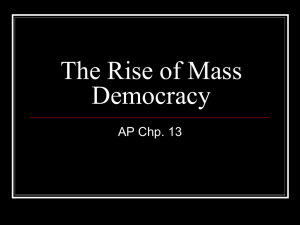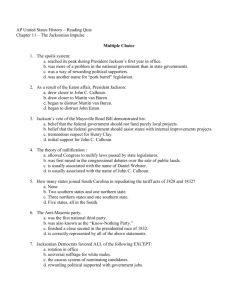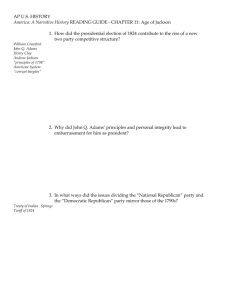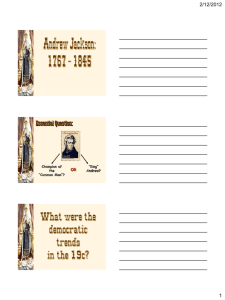Jacksonian Democracy
advertisement
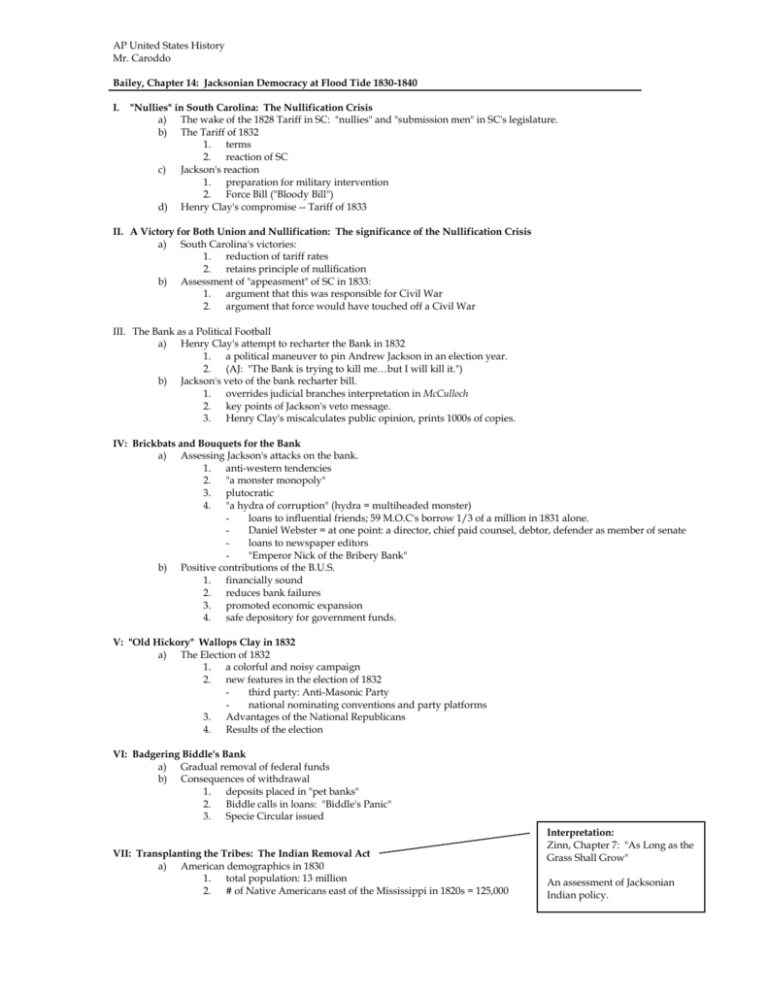
AP United States History Mr. Caroddo Bailey, Chapter 14: Jacksonian Democracy at Flood Tide 1830-1840 I. "Nullies" in South Carolina: The Nullification Crisis a) The wake of the 1828 Tariff in SC: "nullies" and "submission men" in SC's legislature. b) The Tariff of 1832 1. terms 2. reaction of SC c) Jackson's reaction 1. preparation for military intervention 2. Force Bill ("Bloody Bill") d) Henry Clay's compromise -- Tariff of 1833 II. A Victory for Both Union and Nullification: The significance of the Nullification Crisis a) South Carolina's victories: 1. reduction of tariff rates 2. retains principle of nullification b) Assessment of "appeasment" of SC in 1833: 1. argument that this was responsible for Civil War 2. argument that force would have touched off a Civil War III. The Bank as a Political Football a) Henry Clay's attempt to recharter the Bank in 1832 1. a political maneuver to pin Andrew Jackson in an election year. 2. (AJ: "The Bank is trying to kill me…but I will kill it.") b) Jackson's veto of the bank recharter bill. 1. overrides judicial branches interpretation in McCulloch 2. key points of Jackson's veto message. 3. Henry Clay's miscalculates public opinion, prints 1000s of copies. IV: Brickbats and Bouquets for the Bank a) Assessing Jackson's attacks on the bank. 1. anti-western tendencies 2. "a monster monopoly" 3. plutocratic 4. "a hydra of corruption" (hydra = multiheaded monster) loans to influential friends; 59 M.O.C's borrow 1/3 of a million in 1831 alone. Daniel Webster = at one point: a director, chief paid counsel, debtor, defender as member of senate loans to newspaper editors "Emperor Nick of the Bribery Bank" b) Positive contributions of the B.U.S. 1. financially sound 2. reduces bank failures 3. promoted economic expansion 4. safe depository for government funds. V: "Old Hickory" Wallops Clay in 1832 a) The Election of 1832 1. a colorful and noisy campaign 2. new features in the election of 1832 third party: Anti-Masonic Party national nominating conventions and party platforms 3. Advantages of the National Republicans 4. Results of the election VI: Badgering Biddle's Bank a) Gradual removal of federal funds b) Consequences of withdrawal 1. deposits placed in "pet banks" 2. Biddle calls in loans: "Biddle's Panic" 3. Specie Circular issued VII: Transplanting the Tribes: The Indian Removal Act a) American demographics in 1830 1. total population: 13 million 2. # of Native Americans east of the Mississippi in 1820s = 125,000 Interpretation: Zinn, Chapter 7: "As Long as the Grass Shall Grow" An assessment of Jacksonian Indian policy. b) Policies toward Native Americans: 1. diplomatically regarded as separate nations 2. attempts at assimilation of tribes: Society for Propagating the Gospel Among Indians (1787) Congress appropriates $20,000 in 1793 for literacy, agricultural, and vocational training of Indians. 3. The Five Civilized Tribes embrace accomodation: Cherokee Indians as an example settled agricultural life alphabet Cherokee National Council 1808 1828 written constitution slaveholding 4. 1828 Georgia legislative attacks on the Cherokees appeals to Supreme Court Jackson's response 5. The Indian Removal Act of 1830 Trail of Tears (4,000 Cherokees die during 116 day journey to Oklahoma) Bureau of Indian Affairs 1836 6. Indian Resistance Sauk & Fox warriors in Wisconsin 1832 Seminoles 1835-42 costliest Indian conflict in American history Osceola VIII. The Lone Star State Flickers a) Mexican Independence in 1821 opens Texas to American settlement & leads to Texas-Mexican tensions 1. 1823 deal with Stephen Austin 2. Characteristics of Texas-Americans 3. Tensions between Mexicans and Texans prohibition of slavery 4. Santa Anna 1835 b) The Lone Star Republic 1. Texas declares independence 1836 2. Losses at the Alamo & Goliad 3. Victory at San Jacinto IX. Texas: An International Derelict a) Mexican grievances with the United States b) Texas and the United States 1. Jackson recognizes Texan independence in 1837 2. Texas proposes annexation to US 3. Balance of power problems in the Southwest X. The Birth of the Whigs and the Election of 1836 a) The Whig Party emerges 1. "an organized incompatibility" genesis in Clay and Calhoun's 1834 motion to censure Jackson various groups alienated by Jackson: supporters of the American System southern states' righters larger northern industrialists and merchants evangelical Protestants in the Anti-Masonic party b) Presidential election of 1836 1. The Whig strategy 2. William Henry Harrison (Old Tippecanoe) 3. Martin Van Buren 4. Outcome c) Assessing Jackon's presidency 1. Jackson's imprint on the Presidency: positive contributions 2. Jackson's darker legacy: spoils system destruction of the BUS XI. Big Woes for the "Little Magician" a) Van Buren's characteristics b) Difficulties facing Van Buren 1. problems along the Canadian border 2. depression XII. Depression Doldrums and the Independent Treasury a) The Panic of 1837 1. Causes rabid speculation Bank War & Specie Circular crop failures British bank failures 2. Suffering during the Panic b) Whig Proposals for government remedies c) MVB's response 1. "Divorce Bill" -- Independent Treasury Bill 1840 principles behind the bill effect XII. "Tippecanoe" Versus "Little Van" a) The Election of 1840 1. William Henry Harrison, again 2. A "huzza-for-Harrison" campaign strategy The creation of the "hard cider" myth demonization of Martin Van Buren XIII. The Log Cabins and Hard Cider of 1840 a) An intellectual low in campaigning… b) The outcome of the Election of 1840 1. margin of victory 2. nature of the election XIV. The Two Party System Reemerges a) Political differences between the Whigs and the Democrats b) Common threads between Whigs and Democrats

